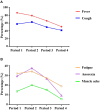The Clinical Characteristics and Prognosis Factors of Mild-Moderate Patients With COVID-19 in a Mobile Cabin Hospital: A Retrospective, Single-Center Study
- PMID: 32582615
- PMCID: PMC7291856
- DOI: 10.3389/fpubh.2020.00264
The Clinical Characteristics and Prognosis Factors of Mild-Moderate Patients With COVID-19 in a Mobile Cabin Hospital: A Retrospective, Single-Center Study
Abstract
Background: Novel mobile cabin hospitals have been built to provide more makeshift beds for patients with COVID-19 in Wuhan. However, the characteristics of these patients needed be further described. Methods: This was a retrospective, single-center study. A total of 869 patients with confirmed COVID-19 were admitted to Wuchang Mobile Cabin Hospital in Wuhan, between February 6th, 2020 and February 20th, 2020. The final date of follow-up was March 6th, 2020. Clinical characteristics and outcome data were collected and analyzed. Results: Of 869 patients, the median age was 51 years (IQR, 40-58 years), and 377 patients (377/869; 43.4%) were men. A total of 616 patients (616/869; 70.9%) were discharged, 95 patients (95/869; 10.9%) were transferred to the designated hospital due to worsening condition (endpoint), and 158 patients (158/869; 18.2%) were still in the hospital. The incidence of the main symptoms, including fever, cough, fatigue, muscle aches, and anorexia, decreased with time. However, there were no differences in outcome among the patients with different onset times. Generally, both patients aged 45 years or older and patients with comorbidities were more likely to reach the endpoint (transfer to designated high-level hospitals due to condition worsen). In the other model, patients with the lung CT feature (e.g., ground-glass opacity, reticular/linear, air bronchogram, or consolidation shadow) were more likely to reach the endpoint. Conclusion: Older age, comorbidity, special chest CT features (e.g., ground-glass opacity, reticular/linear, air bronchogram, or consolidation shadow) are associated with poor prognosis for mild-moderate patients. The initial symptoms of mild-moderate patients may become insidious, which deserves our attention.
Keywords: COVID-19; clinical dynamics; mild-moderate patients; novel mobile cabin hospitals; prognosis.
Copyright © 2020 Zhang, Wang, Zhao, Guo, Xu, Ye, Ding, Wang, Ye, Pan, Liu, Li, Luo, Liu and Wan.
Figures


Similar articles
-
Clinical Characteristics and Outcomes of 421 Patients With Coronavirus Disease 2019 Treated in a Mobile Cabin Hospital.Chest. 2020 Sep;158(3):939-946. doi: 10.1016/j.chest.2020.05.515. Epub 2020 May 8. Chest. 2020. PMID: 32437696 Free PMC article.
-
Clinical Features of 33 Cases in Children Infected With SARS-CoV-2 in Anhui Province, China-A Multi-Center Retrospective Cohort Study.Front Public Health. 2020 Jun 16;8:255. doi: 10.3389/fpubh.2020.00255. eCollection 2020. Front Public Health. 2020. PMID: 32612971 Free PMC article.
-
Imaging and clinical features of patients with 2019 novel coronavirus SARS-CoV-2.Eur J Nucl Med Mol Imaging. 2020 May;47(5):1275-1280. doi: 10.1007/s00259-020-04735-9. Epub 2020 Feb 28. Eur J Nucl Med Mol Imaging. 2020. PMID: 32107577 Free PMC article.
-
Clinical Characteristics and Diagnostic Challenges of COVID-19: An Update From the Global Perspective.Front Public Health. 2021 Jan 11;8:567395. doi: 10.3389/fpubh.2020.567395. eCollection 2020. Front Public Health. 2021. PMID: 33505949 Free PMC article.
-
Emergency Preparedness and Management of Mobile Cabin Hospitals in China During the COVID-19 Pandemic.Front Public Health. 2022 Jan 3;9:763723. doi: 10.3389/fpubh.2021.763723. eCollection 2021. Front Public Health. 2022. PMID: 35047472 Free PMC article. Review.
Cited by
-
How does centralized isolation treatment strategy affect the medical staff's mental health during the COVID-19 pandemic?Front Public Health. 2023 Jan 4;10:1055564. doi: 10.3389/fpubh.2022.1055564. eCollection 2022. Front Public Health. 2023. PMID: 36684938 Free PMC article.
-
Does the Thymus Index Predict COVID-19 Severity?J Comput Assist Tomogr. 2023 Mar-Apr 01;47(2):236-243. doi: 10.1097/RCT.0000000000001425. Epub 2022 Dec 13. J Comput Assist Tomogr. 2023. PMID: 36728781 Free PMC article.
-
The Key to Increase Immunogenicity of Next-Generation COVID-19 Vaccines Lies in the Inclusion of the SARS-CoV-2 Nucleocapsid Protein.J Immunol Res. 2024 May 29;2024:9313267. doi: 10.1155/2024/9313267. eCollection 2024. J Immunol Res. 2024. PMID: 38939745 Free PMC article. Review.
-
Auditory-Perceptual Evaluation of Vocal Characteristics in Patients with the New Coronavirus Disease 2019.Folia Phoniatr Logop. 2022;74(3):230-237. doi: 10.1159/000518341. Epub 2021 Jul 9. Folia Phoniatr Logop. 2022. PMID: 34348298 Free PMC article.
-
A Physician's Guide for Workers' Return to Work During COVID-19 Pandemic.J Occup Environ Med. 2021 Mar 1;63(3):199-220. doi: 10.1097/JOM.0000000000002118. J Occup Environ Med. 2021. PMID: 33350662 Free PMC article.
References
-
- WHO Main Website (2020). Available online at: https://www.who.int (accessed May 16, 2020).
-
- Coronavirus COVID-19 Global Cases by Johns Hopkins CSSE (2020). Avialable online at: https://coronavirus.jhu.edu/map.html (accessed May 16, 2020).
-
- COVID-19 Surveillance Dashboard by University of University of Virginia (2020). Avialable online at: https://nssac.bii.virginia.edu (accessed May 16, 2020).
-
- China NHCO . The Diagnosis and Treatment of Pneumonia Infected by Novel Coronavirus (6th trial edition) (2020). - PubMed
Publication types
MeSH terms
LinkOut - more resources
Full Text Sources
Medical

